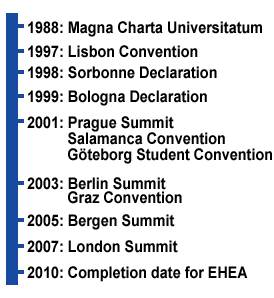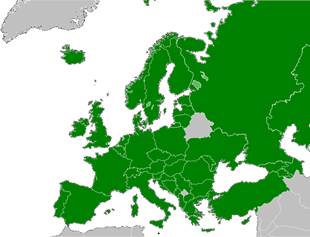Ukraine produces the fourth largest number of academic graduates in Europe
UNIT 1
Educational systems
Ukraine and Bologna process

Read and memorize the following words, words combinations and word-groups:
Purpose - мета
quality assurance standards – стандарти гарантії якості
compatible - сумісний
signatory – сторона, що підписує документ
Magna Charta Universitatum – Велика університетська хартія
framework- структура
commit – зобов’язатися
ECTS - Європейска система переводу й накопичення кредитів
response – дія у відповідь, реакція, відгук
issue- питання, проблема
governance – управління, керування
implementation - впровадження
further - подальший
to benefit – отримувати вигоду, користь
employment – зайнятість, (тут) – влаштування на роботу
cutting-edge – надсучасний, передовий
convergence – зближення, взаємодія
eligible- той, що має право на
stipulate – обумовлювати, ставити за умову
expansion - розширення
curriculum – навчальний план
provision - забезпечення
approach - підхід
elimination - видалення
 1. The purpose of the Bologna Process (or Bologna Accords) is the creation of the European Higher Education Area by making academic degree standards and quality assurance standards more comparable and compatible throughout Europe. It is named after the place it was proposed, the University of Bologna, with the signing in 1999 of the Bologna declaration by Education Ministers from 29 European countries. It was opened up to other countries signatory to the European Cultural Convention of the Council of Europe; further governmental meetings have been held in Prague (2001), Berlin (2003), Bergen (2005), London (2007), and Leuven (2009).
1. The purpose of the Bologna Process (or Bologna Accords) is the creation of the European Higher Education Area by making academic degree standards and quality assurance standards more comparable and compatible throughout Europe. It is named after the place it was proposed, the University of Bologna, with the signing in 1999 of the Bologna declaration by Education Ministers from 29 European countries. It was opened up to other countries signatory to the European Cultural Convention of the Council of Europe; further governmental meetings have been held in Prague (2001), Berlin (2003), Bergen (2005), London (2007), and Leuven (2009).
2. Before the signing of the Bologna declaration, the Magna Charta Universitatum (MCU) had been issued at a meeting of university rectors celebrating the 900th anniversary of the University of Bologna – and thus of (Western) European universities – in 1988. One year before the Bologna declaration, education ministers signed the Sorbonne declaration in Paris 1998, committing themselves to "harmonising the architecture of the European Higher Education system".
Timeline: The Bologna Process

The Bologna Zone
3. The basic framework adopted is of three cycles of higher education qualification. As outlined in the Bergen Declaration of 2005, the cycles are defined in terms of qualifications and European Credit Transfer and Accumulation System (ECTS) credits:
· 1st cycle: typically 180–240 ECTS credits, usually awarding a Bachelor's degree.
· 2nd cycle: typically 90–120 ECTS credits (a minimum of 60 on 2nd-cycle level). Usually awarding a Master's degree.
· 3rd cycle: Doctoral degree. No ECTS range given.
In most cases, these will take 3, 2, and 3 years respectively to complete. The actual naming of the degrees may vary from country to country.
One academic year corresponds to 60 ECTS-credits that are equivalent to 1,500–1,800 hours of study. The new model comes closer to the North American and Japanese systems. It gives greater weight to practical training and to intensive research projects. The way credits are measured reflects how hard a student has worked. The new evaluation methods reflect not only a student's performance on exams, but also his or her lab experiments, presentations, hours spent on study, innovation capacities, and so forth.
4. The Bologna Process was a major reform created with the goal of providing responses to issues such as the public responsibility for higher education and research, higher education governance, the social dimension of higher education and research, and the values and roles of higher education and research in modern, globalized, and increasingly complex societies with the most demanding qualification needs.
 With the Bologna Process implementation, higher education systems in European countries are to be organized in such a way that:
With the Bologna Process implementation, higher education systems in European countries are to be organized in such a way that:
· it is easy to move from one country to the other (within the European Higher Education Area) – for the purpose of further study or employment;
· the attractiveness of European higher education has increased, so that many people from non-European countries also come to study and/or work in Europe;
· the European Higher Education Area provides Europe with a broad, high-quality advanced knowledge base, and ensures the further development of Europe as a stable, peaceful and tolerant community benefiting from a cutting-edge European Research Area;
· there will also be a greater convergence between the U.S. and Europe as European higher education adopts aspects of the American system.
5. Since the mid-90s, Ukraine took steps to reform its education frameworks in consistence with the Bologna Process. Ukraine joined the Bologna process in 2005. By mid-2000s, most Universities grant lower Bachelor's degree (about 4 years) and higher Master's degree (about 6 years). In the Soviet times the only degree was Specialist, which is discontinued by now. Masters are eligible for post-graduate courses. The post-graduate system (Aspirantura) has not been reformed, with Candidate of Sciences and Doktor nauk degrees being granted.

Ukraine produces the fourth largest number of academic graduates in Europe.
6. For Ukraine participation in the Bologna process is a chance of realizing Eurointegration strategy, assisting to improving education quality, solving the problem of recognition of the Ukrainian diplomas abroad. The primary goal is to introduce the system of academic credits stipulated by the Bologna declaration which is similar to ЕСТS (European credit- transfer system). It is considered as a means of students' mobility increase for transition from one curriculum to another, including programs of postgraduate education, as well as reforming curriculums and transfer of credits to higher educational establishments of other countries. An important point of introducing accumulative credit system is the possibility to take into account all student's achievements, not just an academic load, for example, participation in researches, conferences, subject Olympiads, etc.
7. The further actions for achievement of the Bologna process purposes are as follows: adoption of clear and adequate degrees system; inclusion of the two-cyclic education system (two-stage and subsequent training); introduction of the credits' system, i.e. system of credits accruing (ECTS) or its other joint systems which are capable to provide both differential-distinctive and accruing functions; contribution to students and teachers' mobility (elimination of barriers to free students and teachers' moving); provision of higher education high-quality standards; assistance to the European higher education approach (introduction of curricula, courses, modules with the "European" contents); long life training; common work of higher educational establishments and students as competent, active and constructive partners in establishment and formation of the European higher education area.
  
| |